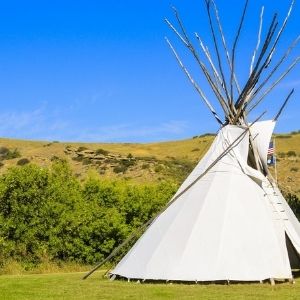About State Parks
You might think of Montana's 55 state parks as "our parks". While we are blessed to have Glacier National Park, Yellowstone National Park and numerous other federal lands to enjoy, no other entity represents the full spectrum of the Montana experience like Montana State Parks. They are used by and designed for Montanans, by Montanans and include world-class recreation opportunities, some of our most important historic sites, and a fantastic representation of many facets of Montana culture.

Les Mason
This wooded area on the east shore of Whitefish Lake provides access to cool, clear waters along a stretch of smooth cobble beach.
Whitefish Lake
This small park provides a mature forest and a pleasant campground and beach.
Lone Pine
Overlooks and trails present dramatic views of the Flathead Valley.
Marias River
Brush Lake
Brush Lake is a deep, clear lake with white, sandy beaches surrounded by grass fields.
Hell Creek
This park provides facilities for most water sports, as well as, excellent walleye fishing.
Makoshika
Montana's largest state park, the pine and juniper studded badland formations house the fossil remains of such dinosaurs as tyrannosaurus rex and triceratops.
Pirogue Island
Floaters find this isolated cottonwood-covered Yellowstone River island an excellent spot to view wildlife.
Medicine Rocks
Medicine Rocks was a place of 'big medicine' where Indian hunting parties conjured up magical spirits.
Tongue River Reservoir
The Tongue River provides a 12-mile long reservoir set in the scenic red shale and juniper canyons
Rosebud Battlefield
Rosebud Battlefield, a National Historic Landmark, is associated with the Great Sioux War of 1876-1877.
Chief Plenty Coups
Featuring the home of Plenty Coups, last chief of the Crow.
Pictograph Cave
A new, sandstone-hued interpretive center rises at the foot of rimrocks where Pictograph Cave has drawn human beings for over 3,000 years.
Yellowstone River
Lake Elmo
This 64-acre reservoir is a popular swimming, non-motorized boating, and fishing area.
Greycliff Prairie Dog Town
This 98-acre park offers a unique opportunity to observe the prairie dog community in its natural environment.
Cooney
This reservoir is a popular recreation area serving south-central Montana.
Clark's Lookout
This outcropping above the Beaverhead River provided the Lewis and Clark Expedition a view of the route ahead.
Bannack
The best preserved of all Montana ghost towns.
Beaverhead Rock
This natural landmark resembles the head of a swimming beaver.
Madison Buffalo Jump
This high limestone cliff was used for 2,000 years by Native Americans.
Missouri Headwaters
Within the boundaries of this scenic park the Jefferson, Madison, and Gallatin rivers merge to form the 2,300 mile Missouri River.
Lewis & Clark Caverns
Montana's first and best-known state park showcases one of the most highly decorated limestone caverns in the Northwest.
Painted Rocks
Located in the scenic Bitterroot Mountains, this 23-acre park offers boating and water sport opportunities on the reservoir.
Anaconda Smoke Stack
One of the tallest free-standing brick structures in the world at 585 feet.
Elkhorn
Backcountry roads settle you into a 19th century mining landscape before you reach historic Elkhorn.
Lost Creek
Spectacular grey limestone cliffs and pink and white granite formations rise 1,200 feet above the canyon's narrow floor.
Granite Ghost Town
This is one of the best of all ghost camps and was the richest silver mine on the earth.
Spring Meadow Lake
This 30-acre spring-fed man-made lake is noted for its clarity and depth.
Ackley Lake
Smith River
The Smith River is unique in that it has only one public put-in and one public take-out for the entire 59-mile segment of river.
Black Sandy
Extremely popular weekend boating, fishing, and water skiing take-off point.
Sluice Boxes
Soaring cliffs and precipitous ledges mark the Belt Creek Canyon as it slices out of the Little Belt Mountains.
Giant Springs
Discovered by the Lewis and Clark Expedition in 1805 and one of the largest freshwater springs in the country.
First Peoples Buffalo Jump
This site may be the largest bison cliff jump in North America.
Tower Rock
This famous rock became a landmark for native tribes, fur trappers and many more that followed in their footsteps.
Beavertail Hill
One-half mile of Clark Fork frontage that provides fishing and floating opportunities.
Fort Owen
Fort Owen is the site of many “firsts” including the first Catholic Church in Montana in 1841.
Travelers Rest
See the only archaeologically verified campsite of the Lewis and Clark Expedition in the nation.
Milltown
Rivers, trails and history converge at Montana's newest state park.
Council Grove
This park marks the site of the 1855 council between Isaac Stevens and the Flathead, Kootenai, and Pend d'Oreille Indians.
Salmon Lake
A natural impoundment, Salmon Lake is one of the beautiful links in the chain of lakes on the Clearwater River.
Placid Lake
Located on a branch of the Clearwater River, Placid Lake is known for its good trout fishing and smooth water.
Frenchtown Pond
Frenchtown Pond is a favorite place to practice boardsailing, kayaking, canoeing, and snorkeling.
Fish Creek
Fish Creek State Park Experience this beautiful, wilderness park.
Thompson Falls
This shaded, quiet campground is located on the Clark Fork River in the rugged and beautiful Clark Fork Valley.
Flathead Lake
Logan
With frontage on the north shore of Middle Thompson Lake, it's a spot for swimming, boating, camping, water-skiing, and fishing.
Montanans agree. State parks hosted nearly 2.5 million visitors in 2015; that’s more than double the number of visitors than just a decade ago. Montanans of all ages, incomes and interests accounted for 80% of those visits—because Montana's state parks are for all of us. Parks are popular, front-country experiences that help us get outside and enjoy Montana's one-of-a-kind outdoor heritage.
For more information, visit the Montana State Parks website.













